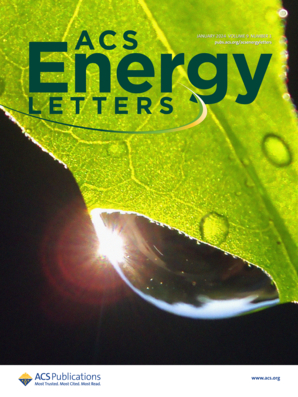Machine-Learning Force Fields Reveal Shallow Electronic States on Dynamic Halide Perovskite Surfaces
IF 19.3
1区 材料科学
Q1 CHEMISTRY, PHYSICAL
引用次数: 0
Abstract
Previous studies indicated that defects in halide perovskites can generate shallow electronic states, which are crucial for their performance in devices. However, how shallow states persist amid pronounced atomic dynamics on halide perovskite surfaces remains unknown. We reveal that electronic states at surfaces of prototypical CsPbBr3 are energetically distributed at room temperature, akin to well-passivated inorganic semiconductors, despite the presence of undercoordinated atoms and cleaved bonds. Notably, approximately 70% of surface-state energies appear within 0.2 eV of the valence-band edge. Although deep states can still form, they are rarely energetically isolated and are less likely to act as traps. Accelerating first-principles calculations via machine learning, we show that the unique atomic dynamics in halide perovskites render the formation of deep electronic states at their surfaces unlikely. These findings reveal the microscopic mechanism behind the low density of deep states at dynamic halide perovskite surfaces, which is key to their device performance.

机器学习力场揭示动态卤化物钙钛矿表面的浅电子态
先前的研究表明,卤化物钙钛矿中的缺陷可以产生浅电子态,这对它们在器件中的性能至关重要。然而,在卤化物钙钛矿表面的明显原子动力学中,浅态如何持续仍然未知。我们发现,在室温下,CsPbBr3原型表面的电子态是能量分布的,类似于钝化良好的无机半导体,尽管存在不配位原子和劈开键。值得注意的是,大约70%的表面态能量出现在价带边缘的0.2 eV内。虽然深层状态仍然可以形成,但它们很少是能量孤立的,也不太可能成为陷阱。通过机器学习加速第一性原理计算,我们表明卤化物钙钛矿中独特的原子动力学使其表面不太可能形成深电子态。这些发现揭示了动态卤化物钙钛矿表面低密度深态背后的微观机制,这是其器件性能的关键。
本文章由计算机程序翻译,如有差异,请以英文原文为准。
求助全文
约1分钟内获得全文
求助全文
来源期刊

ACS Energy Letters
Energy-Renewable Energy, Sustainability and the Environment
CiteScore
31.20
自引率
5.00%
发文量
469
审稿时长
1 months
期刊介绍:
ACS Energy Letters is a monthly journal that publishes papers reporting new scientific advances in energy research. The journal focuses on topics that are of interest to scientists working in the fundamental and applied sciences. Rapid publication is a central criterion for acceptance, and the journal is known for its quick publication times, with an average of 4-6 weeks from submission to web publication in As Soon As Publishable format.
ACS Energy Letters is ranked as the number one journal in the Web of Science Electrochemistry category. It also ranks within the top 10 journals for Physical Chemistry, Energy & Fuels, and Nanoscience & Nanotechnology.
The journal offers several types of articles, including Letters, Energy Express, Perspectives, Reviews, Editorials, Viewpoints and Energy Focus. Additionally, authors have the option to submit videos that summarize or support the information presented in a Perspective or Review article, which can be highlighted on the journal's website. ACS Energy Letters is abstracted and indexed in Chemical Abstracts Service/SciFinder, EBSCO-summon, PubMed, Web of Science, Scopus and Portico.
 求助内容:
求助内容: 应助结果提醒方式:
应助结果提醒方式:


